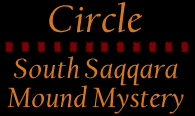
Click on any picture to view a larger image.
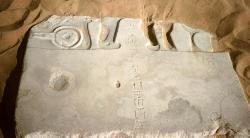 |
Amid the ruins of Pepi II's pyramid and temple
complex lies an unusual stone block. At first glance the
stone upon which the carving is etched seems normal enough
and has many features we have seen many times before in
Egypt. However, one carving in particular on this stone
is quite unique and demands more attention. |
| It seems to point to Egypt's long lost past,
to a time well before Dynastic Egypt the Pharaohs we have
come to know so well. Ancient times from which we now only have
a handful of myths to point the way.
Pepi II, last Pharaoh
of the VI Dynasty, built his pyramid at South Saqqara. The
site today is approximately an hours walk from Zoser's Step
Pyramid complex at North Saqqara across the open desert
and these days it is a fairly remote site. Closer to Dashur
than North Saqqara, there are a wealth of 5th and 6th Dynasty
pyramid complexes in the area, as well as later constructions.
It is not entiely clear why Pepi II built his pyramid in
this spot. It is situated very close to a huge Mastaba tomb,
attributed to Shepseskaf, last king of the IV Dynasty, and
the site was obviously of great significance to both kings. |
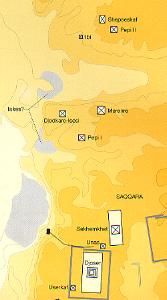
Map of South Saqqara in relation
to Zjosers complex (taken from The complete pyramids by
Mark Lehner)
|
| 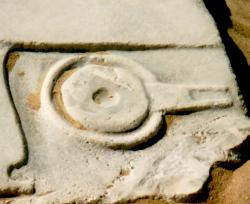
Close-up of "circle" carving
|
The carving in question is the one on the left.
Half hidden in the sand it caught my eye for some reason and
I quickly dug it out for closer inspection. I had seen nothing
resembling it before in Egyptian carvings or texts so was
curious. The first thought that jumped to my mind was that
this was a depiction of a henge, similar to those found
in Great Britain and Western Europe. The most famous henge
in England must be Avebury where there is also a stone circle. |
|
Intrigued as to why I should be looking at what appeared
to be a European monument in the sands of Egypt I decided
to investigate the matter further. It turned out that the idea might
not be as far-fetched as it first sounds. |
| My attempts at uncovering this stone's origins
led me to discover that the stone block itself represented
an offering table, an "htp". These were highly ritualistic
objects erected at Temples and the table was covered with
representations of offering jars and bowls. So, all the carvings
were seen on other such tables? The answer was no. The carving
in question seemed to be unique and did not seem to fit the
standard model which was unusual as these were ritualistic
objects and the carvings were stylised and used generation
after generation. |
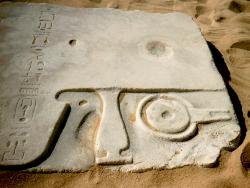
|
| I was told that what I was looking at may
possibly be the top of an offering jar, however, in
all other depictions the jar looks completely different
and is always square. So it seems as if we have a unique
carving here and must look for answers elsewhere.
Looking at the carving in detail, and assuming
for a moment that it does depict a henge/temple of some
description, there are certain features that stand out.
It appears as if there is a central mound with a ditch around
it, possibly containing a moat. There also seems to be an
avenue leading to the central mound. This could actually
be a ramp of some sort as it clearly leads up to and over
the outer ditch. There is the hint of a passage of some
sort leading up the avenue and then penetrating the mound. |
| 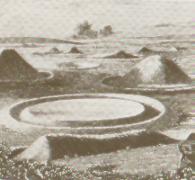
Picture from Secrets of the Great
Pyramid by Peter Tompkins
|
Let's compare the carving
with details from the European henges to see if we do have
a likeness. The following pictures are from Secrets of the
Great Pyramid by Peter Tompkins. It is not mere coincidence
that these pictures are in this book. Tompkins draws many
comparisons between the henges, mounds and circles of Europe
and the Great pyramid, showing time and again how both could
have been used as observatories to aid in the science of
astronomy. |
| Both types of monument give
us very accurate star readings and Tompkins raises the idea
that this possibly was the main purpose of both types of
structures.
Many of the European monuments bear striking
resemblance to our carving. At Maes Howe, the structure
itself even has the avenue shown clearly in the carving.
Another ancient European structure that bears close affinity
with our carving - the likeness of which raises many interesting questions
is the Treasury of Atreus - standing at Mycenae in Greece. |
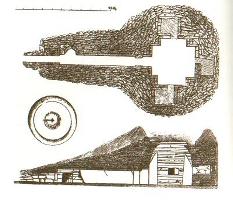
Maes Howe
Picture from Secrets of the Great Pyramid by Peter Tompkins |
| 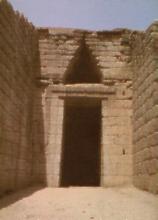
Entrance to the Treasury of
Atreus
Picture from In search of the Trojan war by Michael Wood
Having accepted that there was a case for this carving
being a depiction of some kind of temple or mound I now
had to work out what the link was with ancient Egypt. I
was surprised by my next discovery.
Schwaller De Lubicz
was a German academic who had spent 15 years of his life at Luxor, studying the great temples, and he seemed to have documented a temple very much like the building I had found carved on the block of stone at South Saqqara. |
It has the familiar entrance
leading to it's circular, beehive construction.
The Treasury of Atreus is built in the style of "Cyclopean"
architecture, a term often used to describe certain remains
in Egypt. That there are definite links is beyond question.
The famous Lion Gate also at Mycenae is thought to be the
oldest of it's kind in Europe and the use of lions in it's
symbolism is intriguing to say the least.
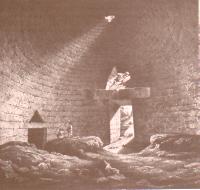
Interior of The Treasury of
Atreus, showing the entrance passage
Picture from In search of the Trojan war by Michael Wood
|
| Amid his works there are many references to the Temples
of Dynastic Egypt being built upon the sites of much older
temples. This was such a common practice that the true age
of the sites in question is hard to guess. Stones from previous
ruined temples were even incorporated into the new temples,
the older parts seen as a seed that grew into the new temple.
The famous temples of Karnak and Luxor were examples of this
practice and the sites had been sacred for a very long time.
It was in the Middle Kingdom that these two temple complexes
were continuously added to, in the case of Karnak for two
thousand years. |
In "The Temple in Man",
De Lubicz shows that underneath the current remains of the
Middle Kingdom temple of Medamud at Luxor, there was a much
older temple, originally built on virgin soil. This temple
bears amazing similarity to our carving. How old this original
temple would have been is hard to estimate but it is likely
to originate deep in Egypt's past.
Looking at this image of Medamud and the image I had found carved at South Saqqara, the two looked very similar. |

Early Temple at Medamud
|
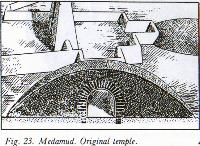 |
So, the mound we can see in
the carving seems to have real roots in Egypt's past. What
were these mounds though? How did they fit into Egypt's
mythology? We are so used to seeing the all too familiar
temples and pyramids of Egypt that the thought of these
mounds seems strangely alien.
There are references to mounds in Egyptian
religious texts however. These are the mounds of creation,
spoken about in the Building texts of Edfu in particular.
|
| They seem to have been of great importance
and feature in Egypt's myths concerning creation. Many believe
these mounds of creation are merely symbolic, however what
if they really did exist and we are looking at a representation
of one such mound in this carving at South Saqqara?
Andrew Collins describes these mounds in detail,
as well as the Edfu Texts that refer to them, in his book
Gods of Eden. The Texts in question, he explains, scribed
onto the walls of Edfu Temple, have titles such as Specification
of the Mounds of the Early Primeval Age and Sacred
Book of the Early Primeval Age of The Gods. Also known
as the Island of the Egg, Collins goes on to describes this
structure.
"Surrounding this mound or hill, known
then as The Island of the Egg, was a circle or 'channel'
of water..."
This sounds very much like our carving. So,
it would appear that what we are looking at is a depiction
of the very mounds that once stood in Egypt's past, now
buried beneath much later temples built on their very foundations,
mounds that later came to represent early Egypt's religious
beginnings. The reference to these mounds as Island of the
Egg is interesting, and this association with eggs and birth
is worth noting, because many of the European circles/henges
have associations with fertility and birth. Avebury itself,
seems to be a represention of fertilised eggs in the womb
(see diagram below). It would appear as if we are seeing
traces of a culture with a unified belief system that was
spread out across Europe and the Middle East. The builders
of the Megalithic period were once thought to be confined
solely to Europe, but evidence of these mounds found in
Ancient Egypt seem to further contradict this view.
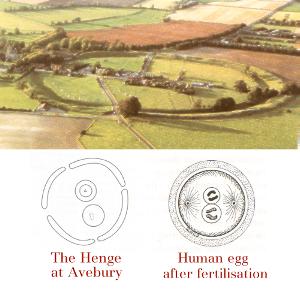
It struck me that the site of Pepi II's pyramid
complex where the carving lies may have been built on top
of one of these sacred mounds. That would explain why it
was a sacred site to both Pepi II and Shepseskaf. It is
possible that the slumped remains of the pyramid itself
sits on such a mound. Other pyramids are known to have mounds
inside them. The Great Pyramid itself is probably the most
famous example and the mound of bedrock at the centre of
this colossal monument is well documented. Interestingly
enough there is a grotto within this mound of rock and it
is entirely possible that this may have existed as a simple
chamber in a mound that predates the pyramid by many centuries
or millennia.
The Second and Third Pyramids are reported
to have the same features inside them too. What if that
was the reason for the positioning of these structures?
We have heard Peter Tompkins point out similarities between
the astronomical properties of Megalithic mounds and the
pyramids. Was this merely a progression, from mound to pyramid?
Did the great sacred pyramids need to be built upon these
sacred, and already ancient, mounds of creation? It is an
intriguing thought. |
| At South Saqqara, amid the ruins
of Pepi II, there are one or two very large stones that look
different from the other remains. They looked to me very much
like the huge Megaliths found at stone circles such as Avebury
in England. Although very hard to prove beyond doubt, this
is an exciting idea. Is there any possibility of a stone circle
once occupying the site of Pepi II's pyramid, with an accompanying
henge and mound? |
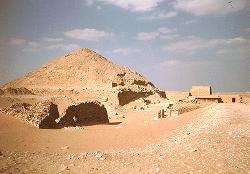
Pepi II's pyramid
|
| A few years ago the answer would have been very clear. Stone
circles in Egypt, what nonsense! In recent times however,
stone circles have indeed been found in Egypt. The most well
known at Nabta Playa. Vaguely resembling the Callanish stones
in the Isle of Skye, the circle at Nabta playa is thought
to have been used to make astronomical calculations long ago.
|
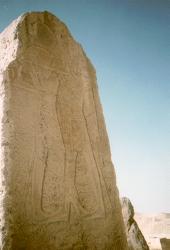 |
Now assume there was a circle
at South Saqqara once. As seems to have been the tradition
in Egypt, older structures are frequently assimilated into
newer forms. The stones from such a circle could well have
been incorporated into Pepi II's temple itself. Is it too
far-fetched to ask whether the stone we see with the carving
upon it was once a standing stone in such a circle, later
to be fashioned into an offering table? It is known that
stones in circles in Europe were often offered libations,
so this is a possibility. One last point of interest here
is that the Egyptian word "htp" used to describe
the stone table where we find our carving has another meaning.
Penelope Wilson in her work A Ptolemaic Lexikon, based upon
the carvings of Edfu, offers an alternative translation
whereby it can mean "to rest", with specific reference
to the setting of the sun. This gives us a tantalising glimpse
into the possible origins of the stone. |
| Maybe it was once standing in some ancient
circle in Egypt, maybe even at South Saqqara, acting as
a marker for the setting sun at certain times of the year.
Did the last rays of the setting sun come to rest upon this
very stone at the equinoxes or on the eve of some festival
of great importance?
Whatever it's full meaning, this one carving
has led me to look at Egypt in a new light and to catch
glimpses of a lost, rich history that is now long forgotten,
apart from the fragments of myth handed down to us across
the yawning gulf that is our past. |
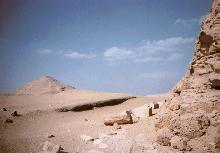
| This page
and all photographs are copyright of Mark James Foster except
where stated. They can only be used with the prior consent
of the author. |

|